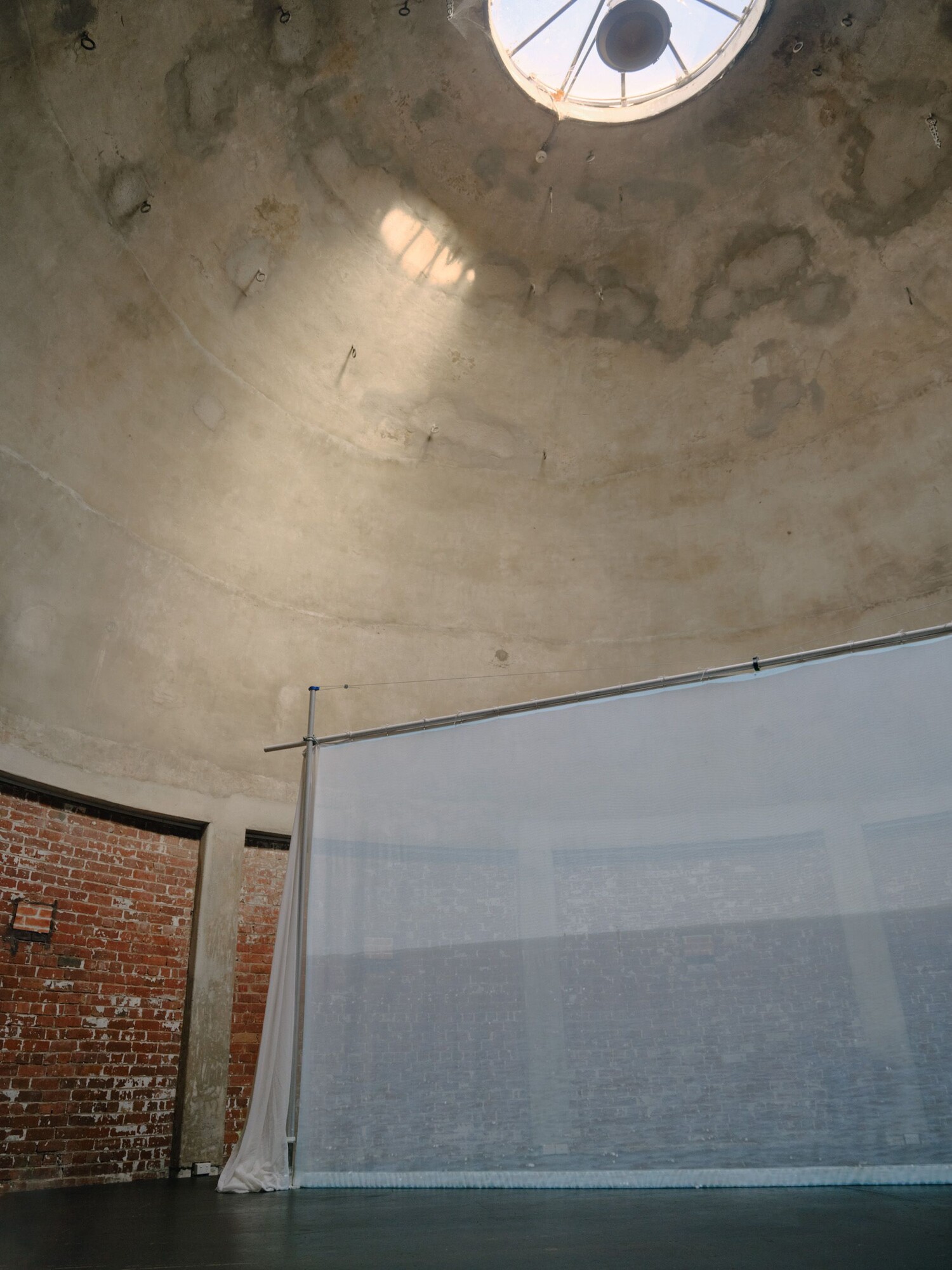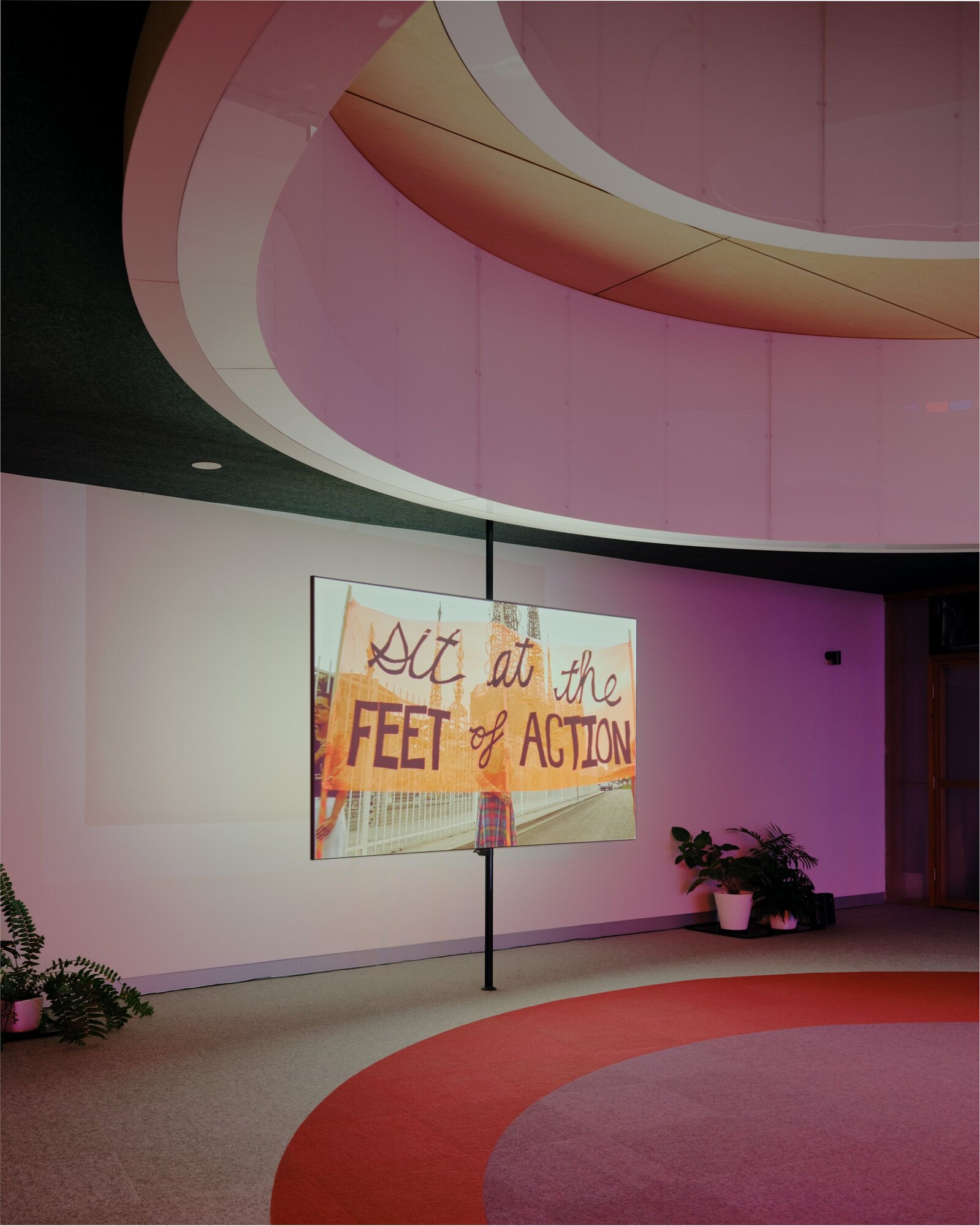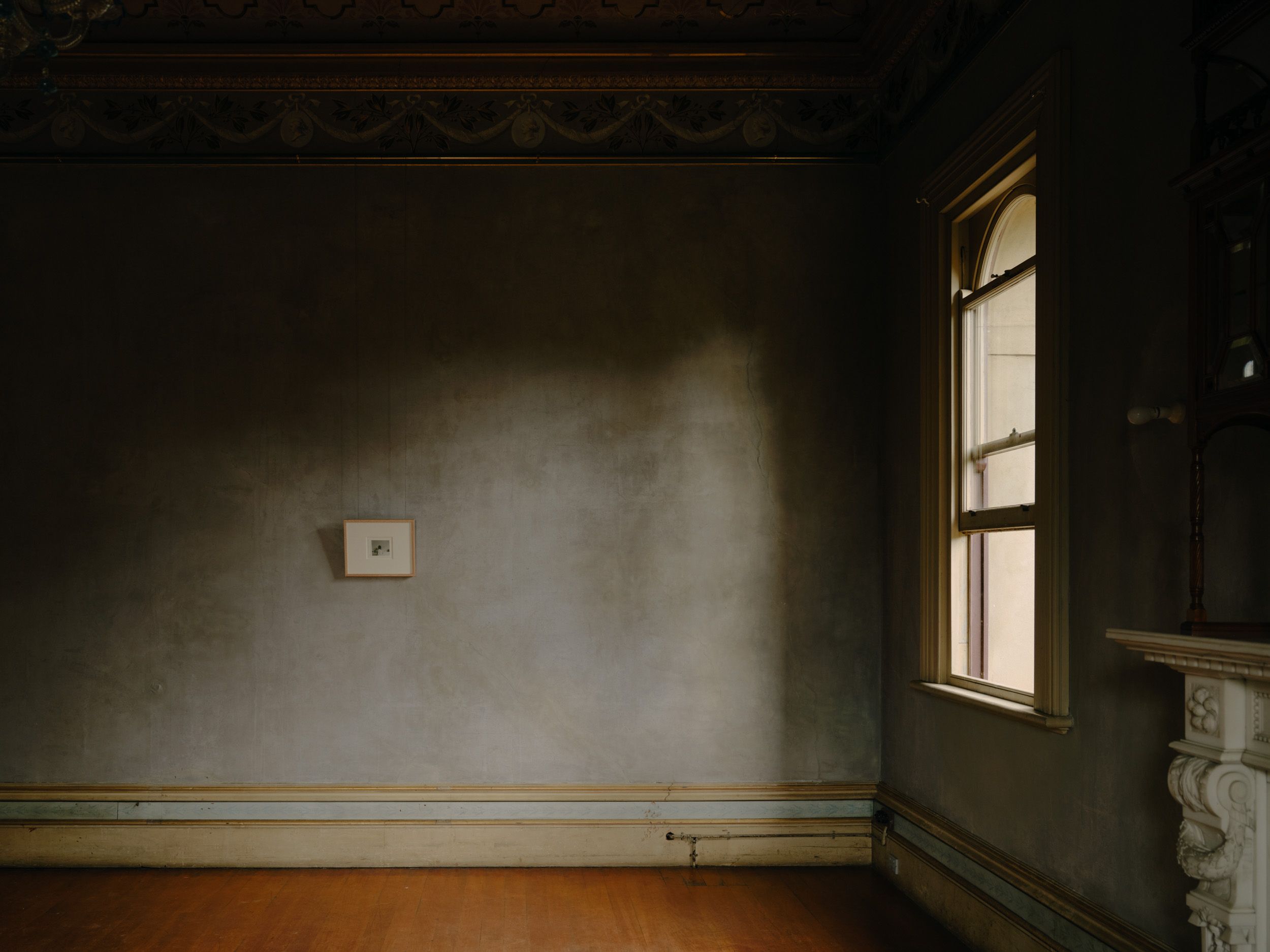Take Hold of the Clouds
Cameron Hurst
Taking hold of clouds can seem like a futile exercise. Clusters of Covid-19 droplets unwittingly expelled from human orifices have been a notably difficult object of capture in the past few years. Even more elusive—and catastrophic—are greenhouse gases. Still, we can grasp in the general direction. A cloud can also function as a metaphor for entities of less threatening composition: good vibes, for example, or the nebulous concept of community. All of the aforementioned cumuli and more were present at Take Hold of the Clouds, an exhibition which took place a couple of weekends ago as part of Open House Melbourne.
Open House is an annual program dedicated to facilitating “public appreciation for architecture and public engagement in conversations about the future of our cities”. This is otherwise known as opportunities for punters to perve on interesting buildings while trying to avoid the jargon-mangled spectacle of architects talking. In her opening night speech, co-curator Tara McDowell described Take Hold of the Clouds as a “distributed exhibition” that approached the “city as a gallery” (Executive Director and Chief Curator of Open House, Fleur Watson, worked alongside McDowell). Work by two international and six local “creative practitioners” (interdisciplinarity has retired “artist”) was hosted in seven sites from St Kilda to Kew. While I was abstractly invested in the ambitious political gambits of Take Hold of the Clouds, the more ephemeral experiences that animated each day were the best parts of the exhibition. Conversations with volunteers about undercover ASIO operatives and camellia flowers; grey daylight on a flaking gilded ceiling; the satisfaction of cresting a hill on a bike in the sun, on the way to another unfamiliar spot in the city.

July 30 was a perfectly clear Saturday. Cycling towards my first Take Hold of the Clouds pitstop, I put in my headphones and clicked Snack Syndicate’s live radio broadcast from Trades Hall, These Thoughts Large and Public. The special guest-filled program continued the duo’s long-term project of surveying the “history and future of labour”. I tuned in as Astrid Lorange and Andrew Brooks spoke with Antony Moore, the Trades Hall Building and Logistics Manager. Moore struck me as a legend. His blokey drawl was punctuated with thoughtful “awww yeahs” and “nahs” and “it all goes back to the Howard years”. The segment was titled “If These Walls Could Talk: Histories of Trades Hall”. Lorange and Brooks kept gently prompting Moore to discuss the past lives of the site as a “literary institute” (the less-used addendum to the original building title), but he was keen to re-orient the discussion to union activities undertaken this century. We need to focus on today’s challenges, he said, and keep renewing the culture that keeps our mighty movement strong. That’s why he chose a current song for his contribution to the broadcast’s “Top 40 (anti-work) Countdown”; it’s important to remember that the union movement isn’t stagnant. It’s up-to-date, contemporary. Brooks and Lorange agreed. “Would you like to introduce your song?” “Yeah”, said Moore. “It’s a new one by Tom Morello. It’s… ah, oh. I can’t remember the name”.
That song was “Hold the Line: Union Strong Edit”, a pop-punk anthem that thundered in my ears as I arrived at the Mission to Seafarers. This community hub is a refuge for mariners on shore-leave, although it is equally welcoming to art critics seeking respite from the glass and steel spiritual wasteland of Docklands. A couple of friends met me inside. Ying-Lan Dann’s installation for Take Hold of the Clouds, Circular Temporalities, was housed in the Mission’s Norla Dome. The Dome was built in 1920 as a gymnasium and is an idiosyncratic structure that resembles a Brutalist observatory. The artist, Dann, also works and teaches as an architect and interior designer. She had made an austere linear intervention to the circular space by trussing a gauzy sheet between three mast-like poles. A video of the ocean as seen from the deck of a ship was projected onto the translucent scrim. The rocking horizon line cleaved two sections of blue (duck egg sky atop dappled steel ocean), forming a palimpsest with the red bricks and mottled concrete of the dome’s far wall. This meditative visual monotony—one wonders how real seafarers do it—was accompanied by an audio component. Justin Clemens had taken time out from playing the big Other to every hapless graduate student at the Clyde Hotel and written a poem for Circular Temporalities. It’s really quite good. We took a printed text, put on expensive-feeling headphones and listened to the poem, titled Orison, read aloud by Dann over a soundscape of creaking wood, synths and bird calls.

Orison is an archaic English word for “prayer” and a near-homophone for “horizon”. Given this lineage and the Christian mission animating the building, it is fitting that Orison reads like a series of invocations. Some lines return cyclically, shifted and rearranged in a lilting rhythm. “So many things are strange but nothing is stranger than/ the humans who set sail on ships that seek/ the images of dream that can’t be found… so much is strange but nothing stranger than/ the shifting shadows of these spinning spheres/ a moving ship upon a moving sea”. McDowell’s catalogue essay tells me that Dann shot this particular stretch of ocean from the ferry between Queenscliff and Sorrento. There is a lovely contrast between the incantatory deep sea placelessness of the audio and this geographical specificity. I imagined the individual seafarers who crossed the same passage, who were stuck on deck for months in lockdown. In the Ship to Shore Mission newsletter, I was struck by the smiling face of Mr Benji Amador Germina from the Philippines, who’d been helped out by the Mission after being hospitalised when his left pinky finger was pinched onboard the (allegedly jinxed) OOCL Houston.
Civic-minded voyeurism animates Open House. How do others live? Mariners, architects, people with nice houses … the Melbourne Quakers Centre was our next stop. (Apparently ASIO operatives used to scout the joint for communists. A volunteer let us know that he was once forced to defend his CPA badge: “Certified Practising Accountant not Communist Party of Australia!” The story had a told-many-times patina, but still hit.) On the ground floor, Fayen d’Evie, coordinator of the “research-led access project” Open Access/ Open House for Take Hold of the Clouds, was leading a workshop. Participants were to consider expanded access possibilities through creating visual descriptions of artworks and exhibitions. D’Evie spoke with warm pedagogical confidence to an attentive group. Upstairs, the circular worship space housed Cauleen Smith’s Sojourner (2018).

Roland Barthes famously characterised the art text as a “tissue of quotations”. Smith’s associative twenty-two minute video is a tissue (or, perhaps more fittingly, a quilt) of Afro-futurist feminist figures, places and texts. In varying film stock, Black women traverse historically important and visually striking built environments—Sun Ra’s house, Noah Purifoy’s Joshua Tree Outdoor Museum, the incredible Watts Towers. Canonical Black American feminist writings are read over a karmically charged Alice Coltrane Turiyasangitananda soundtrack. The film feels almost too culturally specific to travel; it has that particularly American quality of being parochial yet presuming a certain universality. However, this context slippage suited the anachronism of the Quaker presence in West Melbourne.
As Gil Scott Heron famously sang, the revolution will not be televised. It seems unlikely to be riso-printed. Nonetheless, we stopped briefly by Trades Hall to see the Snack Syndicate broadcast in person and pick up some pamphlets. Chelsea Hart was speaking eloquently about reproductive labour and chose a SZA banger for her Countdown Song. Heron again: “The revolution will not be brought to you/ By Xerox in four parts without commercial interruptions”. Will it be brought to us by tea and All Are Welcome pastries? Ok, that’ll do. Making fun of earnest communists with good taste is a timeless sport, but precarity is no joke. Just ask the University of Melbourne about the fresh receipt of legal action by the Fair Work Ombudsman. As the NTEU says (to paraphrase), see you in court, bitch!

On to more legal matters. The other major international import of Take Hold of the Clouds, Forensic Architecture’s Cloud Studies, screened at Walter Burley Griffin and Marion Mahoney Griffin’s The Capitol theatre. Is this Melbourne’s most epic ceiling? Surely. Cloud Studies is also currently exhibited at the Berlin Biennale. The film continues the Goldsmiths-based Forensic Architecture’s NCIS: Decolonial Art World gambit. The group utilise a dizzying schema of graphs, mapping and 3D modelling to represent their investigations into, as founder Eyal Weizman writes, “state and corporate violence, especially when it bears upon the built environment”. Cloud Studies gathers a series of confronting investigations into “toxic clouds”—air weaponised with malicious intent (chlorine bombs in Syria; airborne herbicides in Gaza) or causing immense harm via negligence (the Grenfell Tower fire). Conceptually, Cloud Studies is simple yet effective. Air is as contested as land; it’s just harder to see how and where the violence happens. Forensic Architecture seek to rectify this. A kind of relentless proceduralism carries the project. This is exemplified in the language used by the narrator, a woman who speaks ambiguously accented English in a near-monotone. “We studied … we analysed … we researched … we simulated.”. This is not the diligent kitchen table highlighting of Snack Syndicate nor the speculative transcendentalism of Smith. It is cool techno-collectivism, aimed at The Hague as much as The Capitol. “Well, that was a downer”, said the woman sitting behind me as the credits rolled. The good kind, though, right?

The Brunswick Baths were packed at 7pm with attendees of Alicia Frankovich’s performance The Eye. In the inside pool, the air was warm and chlorinated. An obscured light source beamed amber rays across the still water. McDowell, in her opening night speech, had described the performance as “loosely about climate change”. This gave my expectations a broad remit. Three young people dressed in track pants and baggy t-shirts—club clothes—began manoeuvring around the pool. One had a mullet. One had long, white-blond hair. The third sported a bleached crew cut. They lay on the grates and sunk their arms into the blue. Next, they progressed to the water, where they sank beneath the surface until only their eyes and tips of their noses were visible. It was crocodilian. Periodically, statements about biodiversity and experiences of climate catastrophe were broadcast from a speaker or spoken by the performers into a microphone. It was all very Anne Imhof, if the rottweilers and Balenciaga were swapped for Ceres eco-feminism. After about twenty-five minutes, a group of women sitting in the audience stood up and plunged in. Each took their shoes off and began sloshing down the length of the pool in staggered, southwards lines. Visually, the scene was striking. It bore an uncanny resonance to images of people sheltering in place in Mallacoota during the Black Summer bushfires, huddled, stricken, under sky the colour of dehydrated urine. Hellish. The speaker continued to play readings, collaged from varied sources such as interviews with performers, a windsurfing documentary and Frankovich’s writings. The narration had a similarly flat affect to Cloud Studies, but the subject matter was often highly personal and emotive. “I fear collective inaction … I hope that humans who create problems can solve problems … I sense that people are quite exhausted”. The Eye seemed to want to avoid didactic political forms that explain or call for action, instead allowing for reflection and grief. It looked incredible but, honestly, I couldn’t connect with the texts. The last woman to leave the pool did a handstand, which brought some light relief.

On Sunday afternoon, I visited Julia McInerney’s installation at Villa Alba, Joanna. The building is incredible, a vision of decayed nineteenth-century bourgeois luxury. Visiting felt like walking into a Whistler painting. The quality of light on the pale charcoal walls was reminiscent of Vilhelm Hammershoi’s Interior (1899) currently on display at ACMI in Light: Works from Tate’s Collection. McInerney’s show was thoroughly gorgeous. It comprised several elements, including a series of sparse monochrome photographs hung in contrast to the decorative frescos and a table of deckle-edged papers with short paragraphs printed in an elegant serif. The latter sketched the artist’s research into Ina Higgins, Melbourne’s first female landscape architect. In another room, a flickering projector whirred. Creamy sepia footage of secateurs slicing camellia flowers was accompanied by a mournful Mendelssohn piano soundtrack. There was an ineffable, blurry magic to Joanna that perfectly suited the peeling glory of the Villa.
On opening night, Boon Wurrung Elder N’Arweet Carolyn Briggs addressed Open House’s “Built/Unbuilt” theme by observing that First Nations people have always been “silent partners in the development of this city”. Briggs’ redirection of construction industry vernacular towards First Nations’ sovereignty stuck with me. It was high in my mind the other day when I belatedly trammed to the Esplanade to see the final Take Hold of the Clouds work, Unvanished – (St Kilda) Rainbow Lorikeet #2. Barkindji artist Kent Morris had installed four murals on the St Kilda Vault arches. Morris photographed the gem-like rainbow lorikeets that populate the area and digitally collaged the birds around a series of explosive, diamond-shaped motifs. Pasted into the arches of the Vaults, each panel of the mural sequentially increased in saturation. The brightest finale, with a ring of emerald, tangerine and cerulean lorikeets in various lively poses, seemed to vibrate with the assertion of the work’s title: Unvanished.

Take Hold of the Clouds takes its name from a line in Smith’s film Sojourner, which in turn quotes the Black American Shaker Rebecca Cox Jackson (1795–1871). In a dream, God speaks to Jackson: “You have climbed to the heavens and taken hold of the clouds”. McDowell reflected poignantly on Jackson’s words in her catalogue essay for the show. “The line is an admonition, for her too lofty ambitions and lack of humility, but it’s also a call to recognise her own power”, she wrote. It is an “Icarus-like narrative”, a valorisation of the flight with an inbuilt understanding of inevitable fall. I like this dialectic between radical aim and pragmatic outcome. It’s a fairly chill theoretical stance to curate from, allowing the works relative freedom to expand or contract in response to their architectural contexts without being crammed into an overdetermined framework.
This speaks to my favourite part of Take Hold of the Clouds: the insight it gave into the daily mundanities of esoteric community groups. Each artwork sensitively illuminated the idiosyncrasies of each site. In the alienation left in the wake of the psyche-incinerating pandemic, it’s moving to remember that people do find their weird little pockets of like-minded people in ashrams, unions, shanty-song Thursday nights, film festivals and Christian sects. Researching Rebecca Cox Jackson, I found that apparently there are only three Shakers left alive. Their Wikipedia page informs me that “in the Spring/Summer 2019 issue of the Shaker newsletter The Clarion, the current membership was given as Brother Arnold, Sister June, and Brother Andrew. These remaining Shakers hope that sincere newcomers will join them”. Any takers?
Cameron Hurst is a contributing editor of MeMO Review.


